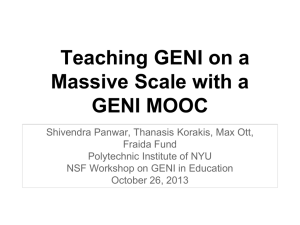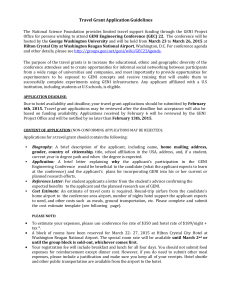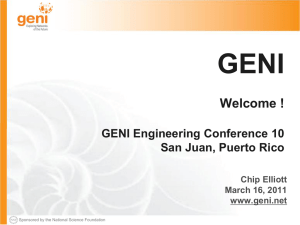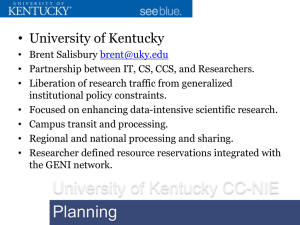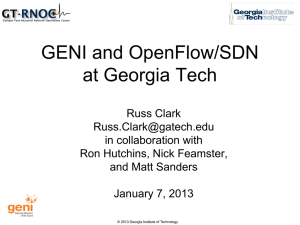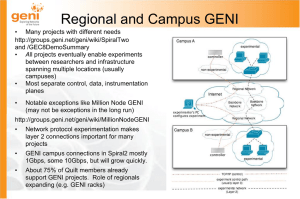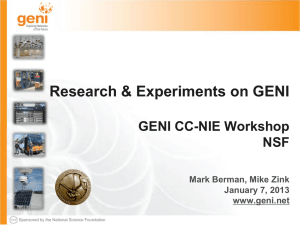substrate optical
advertisement
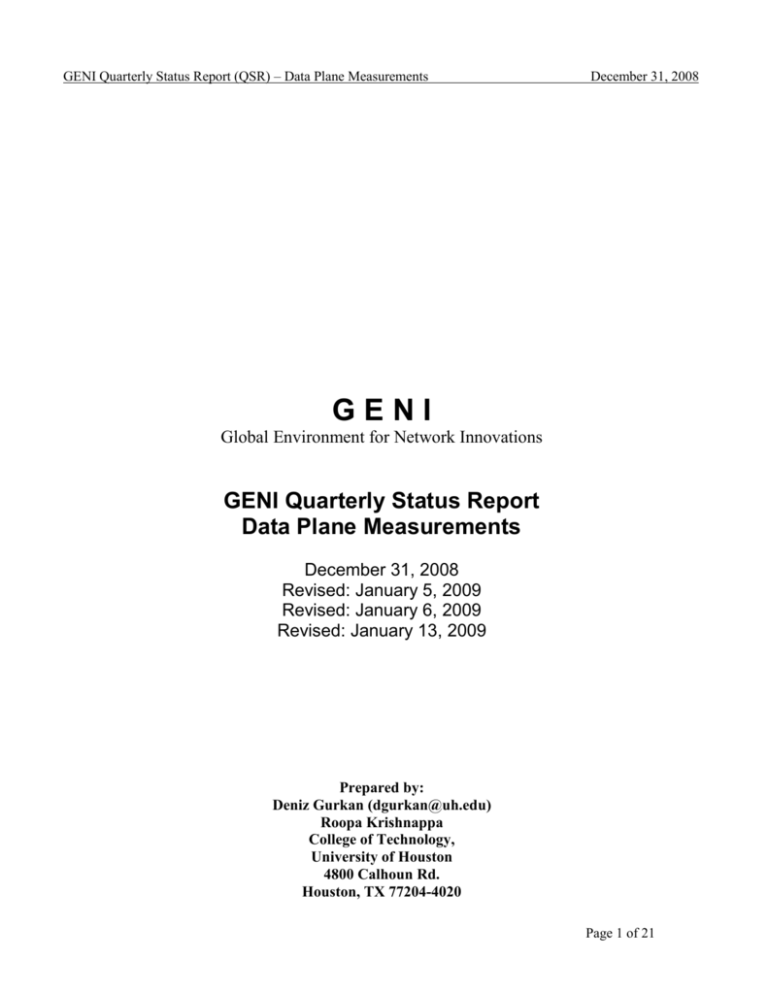
GENI Quarterly Status Report (QSR) – Data Plane Measurements December 31, 2008 GENI Global Environment for Network Innovations GENI Quarterly Status Report Data Plane Measurements December 31, 2008 Revised: January 5, 2009 Revised: January 6, 2009 Revised: January 13, 2009 Prepared by: Deniz Gurkan (dgurkan@uh.edu) Roopa Krishnappa College of Technology, University of Houston 4800 Calhoun Rd. Houston, TX 77204-4020 Page 1 of 21 GENI Quarterly Status Report (QSR) – Data Plane Measurements December 31, 2008 Table of Contents 1 Major accomplishments......................................................................................................................... 3 1.1 1.1.1 Review all substrate technologies in spiral-1 ............................................................................................3 1.1.2 Document Embedded Measurement Capabilities ......................................................................................5 1.1.3 Identify External Measurement Equipment .............................................................................................10 1.1.4 Describe the network connections for external measurements ................................................................11 1.2 2 Milestones achieved ......................................................................................................................................3 Deliverables made .......................................................................................................................................17 Description of work performed during last quarter ............................................................................. 18 2.1 Activities and findings ................................................................................................................................18 2.2 Project participants ......................................................................................................................................21 2.3 Publications .................................................................................................................................................21 2.4 Outreach activities .......................................................................................................................................21 2.5 Collaborations .............................................................................................................................................21 2.6 Other Contributions .....................................................................................................................................21 Page 2 of 21 GENI Quarterly Status Report (QSR) – Data Plane Measurements December 31, 2008 1 MAJOR ACCOMPLISHMENTS 1.1 Milestones achieved 1.1.1 Review all substrate technologies in spiral-1 Review all (optical, wireless, edge compute, etc.) substrate technologies (list provided by GPO) in spiral-1 from a measurement and monitoring point of view. Some prototype information has not been posted yet. This will be a work in progress until January 31st, 2009 deadline of delivery. Cluster: A i) DETER Substrate Technologies: Project wiki: Cluster: B i) Mid Atlantic Network Substrate Technologies: Regional optical network, 10 Gbps DWDM optical nodes, 10 Gbps Ethernet switches, Computer servers Project wiki: http://groups.geni.net/geni/wiki/Mid-Atlantic%20Crossroads ii) GpENI Substrate Technologies: Regional optical network, 10 Gbps optical switches, 10 Gbps Ethernet switches, Programmable Routers, Site-specific experimental nodes Project wiki: http://groups.geni.net/geni/wiki/GpENI iii) Enterprise GENI Substrate Technologies: Campus wide programmable Ethernet switches Project wiki: http://groups.geni.net/geni/wiki/EnterpriseGeni iv) PlanetLab Substrate Technologies: GENI Users Access to PlanetLab (800 nodes/400 sites) Project wiki: http://groups.geni.net/geni/wiki/PlanetLab v) SPP Overlay Page 3 of 21 GENI Quarterly Status Report (QSR) – Data Plane Measurements December 31, 2008 Substrate Technologies: High performance overlay hosting nodes, netFPGA cards Project wiki: http://groups.geni.net/geni/wiki/OverlayHostingNodes Cluster: C i) CMU Testbeds Substrate Technologies: Small scale Emulab testbed, Residential small form-factor machines, Wireless emulator Project wiki: http://groups.geni.net/geni/wiki/CmuLab ii) Proto-GENI Substrate Technologies: Backbone Sites, Programmable 10 GBE Ethernet Switch, PC’s with NetFPGA cards Project wiki: http://groups.geni.net/geni/wiki/ProtoGENI iii) Programmable Edge Node Substrate Technologies: Intel IXP2855 network processor based programmable edge node Project wiki: http://groups.geni.net/geni/wiki/ProgrammableEdgeNode iv) Measurement System Substrate Technologies: PC based IP Packet monitors, Data Storage Systems Project wiki: http://groups.geni.net/geni/wiki/MeasurementSystem Cluster: D i) BEN Substrate Technologies: Regional optical network, Optical fiber switch, 10 Gbps Optical Transport, 10 Gbps Routers/Switches, Site-specific experimental nodes Project wiki: http://groups.geni.net/geni/wiki/ORCABEN ii) DOME Substrate Technologies: Metro mobile network, compute nodes, variety of wireless interfaces, GPS devices, wireless access points Project wiki: http://groups.geni.net/geni/wiki/DOME Page 4 of 21 GENI Quarterly Status Report (QSR) – Data Plane Measurements December 31, 2008 iii) ViSE Substrate Technologies: Multi Sensor (camera, radar, weather station) Network Project wiki: http://groups.geni.net/geni/wiki/ViSE iv) Kansei Sensor Networks Substrate Technologies: Kansei Wireless Sensor Networks Project wiki: http://groups.geni.net/geni/wiki/KanseiSensorNet Cluster: E i) WiMAX Substrate Technologies: IEEE 802.16e WiMAX base-station Project wiki: http://groups.geni.net/geni/wiki/WiMAX ii) Orbit Substrate Technologies: Heterogeneous and Mobile Wireless Testbeds Project wiki: http://groups.geni.net/geni/wiki/ORBIT 1.1.2 Document Embedded Measurement Capabilities Document embedded measurement capabilities of all substrate technologies. Some prototypes do not have this information posted yet. This will be a work in progress until February 28th, 2009 deadline of delivery. Cluster A i) DETER There is no information available as yet. Cluster B i) Mid Atlantic Network Refer to Section 5.5 – Mid Atlantic Network: Measurement and Instrumentation of Spiral1 substrate catalog, document id GENI-INF-PRO-S1-CAT-01.3. Layer 1 equipment (Adva Optical Networking) provides access to optical performance monitoring data, FEC counters (only for 10 G transponders), and SNMP traps for alarm monitoring. Page 5 of 21 GENI Quarterly Status Report (QSR) – Data Plane Measurements December 31, 2008 Layer 2 Ethernet switches provide access to packet counters and error counters. The DRAGON network uses Nagios for monitoring general network health, round-trip time between nodes, etc. Cricket is used for graphing network performance (interface speeds) as well as graphing optical performance monitoring data (light levels, FEC counters, etc). The DRAGON network also has a Perfsonar active measurement point deployed at https://perfsonar.dragon.maxgigapop.net. ii) GpENI Real-time web-based monitoring interfaces will be made available on the GpENI wiki. Ciena CN 4200 is a box available on this network. The measurement capabilities of Ciena CN 4200 are listed below. The measurements are not available for the GENI researcher’s access according to the documentation received from GpENI. Bit error rate. Optical power. Protocol specific performance monitoring like Remote Monitoring (RMON) for Ethernet connections. Performance monitoring on all client and network services. iii) Enterprise GENI Refer to Section 10.5 – Enterprise GENI: Measurement and Instrumentation of Spiral1 substrate catalog, document id GENI-INF-PRO-S1-CAT-01.3. OpenFlow is used to gather statistics at a per flow entry granularity on the routers/switches directly. Users will need to operate an OpenFlow controller to control forwarding decisions in the network. This allows for complete control over L2/L3 forwarding decisions, including experimental protocols which are not IP based. iv) SPP Overlay Refer to Section 11.5 – SPP Overlay: Measurement and Instrumentation of Spiral1 substrate catalog, document id GENI-INF-PRO-S1-CAT-01.3. SPP Overlay will implement the standard PlanetLab mechanisms for auditing outgoing traffic. In addition, the core components provide a large number of low level traffic counters that will be accessible to users and can be used to generate real-time charts of traffic associated with a slice NetFPGA is a programmable hardware. Various measurements should be possible using NetFPGA. However, SPP Overlay group did not specify any specific measurements in their documentation. Page 6 of 21 GENI Quarterly Status Report (QSR) – Data Plane Measurements December 31, 2008 v) Planet Lab There is no information available as yet. Cluster C i) CMU Testbeds Refer to Section 8.5 – CMU Testbeds: Measurement and Instrumentation of Spiral1 substrate catalog, document id GENI-INF-PRO-S1-CAT-01.3. CMU testbeds have standard machine monitoring like interface monitoring, tcpdump/pcap, nagios-style monitoring of machine availability, etc. ii) Proto-GENI Refer to Section 12.5 – Proto-GENI: Measurement and Instrumentation of Spiral1 substrate catalog, document id GENI-INF-PRO-S1-CAT-01.3. Ethernet switches have basic packet counters, and can be configured to "mirror" traffic between ports for collection purposes. The PCs will be able to use standard measurement and capture tools, such as tcpdump. NetFPGA is a programmable hardware. Various measurements should be possible using NetFPGA. However, Proto-GENI group did not specify any specific measurements in their documentation. iii) Programmable Edge Node Refer to Section 13.5 – Programmable Edge Node: Measurement and Instrumentation of Spiral1 substrate catalog, document id GENI-INF-PRO-S1-CAT-01.3. The measurement in PEN can be done on either x86 or network processor (NP). Measurement metrics that can be obtained on network processor are primarily flow statistics, including start-of-flow timestamp, current timestamp, packet count for each direction (host to NP and NP to host), byte count for each direction and the flow tuples. In addition physical NP ports statistics including number of octets, the number of unicast/multicast/broadcast packets, and the numbers of packets of different size intervals that have been sent and received by each physical port can also be measured. iv) Measurement System Refer to Section 14.5 – Measurement System: Measurement and Instrumentation of Spiral1 substrate catalog, document id GENI-INF-PRO-S1-CAT-01.3. Measurement system enables the users to capture packets associated with their experiments. The measurement systems will also generate a set of system utilization measurements that will be available via SNMP and activity logs that will be available via syslog. Page 7 of 21 GENI Quarterly Status Report (QSR) – Data Plane Measurements December 31, 2008 Cluster D i) BEN Polatis 32 fiber Reconfigurable Optical Switch: Refer to Section 7.5 – BEN: Measurement and Instrumentation of Spiral1 substrate catalog, document id GENI-INF-PRO-S1-CAT-01.3. It supports optical power measurement. Polatis - 20 directional optical power monitors (OPM) as specified in the table below: Fiber Input OPM? # Output OPM? Fiber # Input OPM? Output OPM? 1 Yes Yes 17 Yes Yes 2 Yes Yes 18 Yes Yes 3 Yes 19 Yes 4 Yes 20 Yes 5 Yes 21 Yes 6 Yes 22 Yes 7 Yes 23 Yes 8 Yes 24 Yes 9 25 10 26 11 27 12 28 13 29 14 30 15 31 16 32 Input optical power monitors measure light entering the switch Output optical power monitors measure light exiting the switch No optical power monitors on fibers 9-16 and 25-32 Infinera Digital Transport Node (DTN) : The measurement capabilities of Infinera DTN are listed below: Full digital access to the optical layer. Full digital performance monitoring. Page 8 of 21 GENI Quarterly Status Report (QSR) – Data Plane Measurements December 31, 2008 Fault management. Although these measurements are embedded into the nodes, they are not available to the GENI researcher’s access through any software mechanism yet. ii) DOME Refer to Section 9.5 – DOME: Measurement and Instrumentation of Spiral1 substrate catalog, document id GENI-INF-PRO-S1-CAT-01.3. When the computers come up they do a self-check of their health and log the results to UMass server. Once running, the computers on the buses continuously attempt to report their GPS coordinates so that we can determine a computer is running and track the bus's location. The measurement metrics includes SSIDs discovered, whether a bus could communicate with the mesh or other buses, throughput information, etc. The control of the devices has now been ceded to the GENI experiments, and the GENI researchers are free to measure whatever they find useful. The information for 802.11 includes available SSIDs and BSSIDs, signal strength, noise level, and type of security that may be enabled. Since both the raw PCI device and root access is available, all traffic, including beacons, can be recorded using standard tools such as tcpdump. With respect to the GPS device, both interpreted data and access to the raw sentences will be available. iii) Vise Refer to Section 15.5 – Vise: Measurement and Instrumentation of Spiral1 substrate catalog, document id GENI-INF-PRO-S1-CAT-01.3. Each sensor measures attributes of its physical surroundings. The raw reflectivity and voltage data gathered by the radar is stored in NetCDF files. Details of the NetCDF standard may be found at http://www.unidata.ucar.edu/software/netcdf/ and http://en.wikipedia.org/wiki/NetCDF. iv) Kansei Sensor Networks There is no information available as yet. Cluster E i) WiMax Refer to Section 16.5 – WiMax: Measurement and Instrumentation of Spiral1 substrate catalog, document id GENI-INF-PRO-S1-CAT-01.3. WiMax plan to use features of the ORBIT measurement library for collecting real-time measurements for experiments. The library will run on the GBSN controller and record per flow or per packet measurements and maintain databases for each experiment, and make it available through the ORBIT experiment control portal. The framework will handle both Layer 2 and 3 measurements. The collection library will aggregate Page 9 of 21 GENI Quarterly Status Report (QSR) – Data Plane Measurements December 31, 2008 the measurements and send them to a collection server running in the OMF management system. NEC WiMax Base station features are listed in the table below. The Phy, MAC and networking layer information can be retrieved and the information might be useful for researchers. PHY MAC Networking Access mode Frequency DL:UL ratio Channel BW FFT size Frame duration TX output Power # of sectors Head compression SOFDMA/TDD 2535 ~ 2605 MHz 35:12, 26:21, 29:18 10 MHz , 8.75 MHz 1024, 512 5ms 35dBm (max) 3 PHS ARQ MBS support HARQ/CC, ARQ Single BS, multiple BS-MBS Resource management Power control, mode control (idle, sleep etc.) IP protocols IPv4, IPv6 Bridging/Routing Transparent L2 switch, Bridging Packet handling 802.1Q VLAN, PHS**) ii) Orbit There is no information available as yet. 1.1.3 Identify External Measurement Equipment Identify external measurement equipment (if any) and/or recommend where external measurement devices could benefit spiral-1.We identified any external measurement equipment available in the prototype. This will be a work in progress until May 30th, 2009 deadline of delivery. Cluster A i) DETER: There is no information available as yet. Cluster B i) Mid Atlantic Network ii) GpENI iii) Enterprise GENI iv) SPP Overlay SPP Overlay is planning to implement PlanetLab mechanisms for auditing outgoing traffic. Details will be available as the project progresses. v) Planet Lab Page 10 of 21 GENI Quarterly Status Report (QSR) – Data Plane Measurements December 31, 2008 Cluster C i) CMU Testbeds ii) Proto-GENI iii) Programmable Edge Node iv) Measurement System Cluster D i) BEN ii) DOME iii) Vise iv) Kansei Sensor Networks Cluster E i) WiMax ii) Orbit 1.1.4 Describe the network connections for external measurements First, we identified the general network connections in the prototypes. As we recommend external measurement equipment, we will also identify what network connections can be used to share this information. This will be a work in progress until July 22nd, 2009 deadline of delivery. Cluster A i) DETER There is no information available as yet. Cluster B i) Mid Atlantic Network Refer to Section 5.1 – Mid Atlantic Network: Substrate Overview and Section 5.3 – Mid Atlantic Network: Aggregate Physical Network Connections of Spiral1 substrate catalog, document id GENI-INFPRO-S1-CAT-01.3. Mid-Atlantic Crossroads owns and operates the DRAGON network deployed within the Washington, D.C. beltway, connecting ten regional participating institutions and interconnecting with both the Internet2 national backbone network and the National Lambda Rail network. This research infrastructure consists of approximately 100 miles of high-grade fiber connecting five core switching locations within the Washington metropolitan area. Each of these switching locations include optical add/drop multiplexers and state-of-the-art MEMS-based wavelength selectable switches (Adva Optical Networking). These nodes also include 10 Gbps capable Ethernet switches (Raptor Networks). The dedicated research network supporting the GENI spiral-1 prototyping project includes the following locations: University of Maryland, College Park USC ISI-East Arlington, VA Page 11 of 21 GENI Quarterly Status Report (QSR) – Data Plane Measurements December 31, 2008 Qwest Eckington Place NE, Washington, DC George Washington University Level 3 Old Meadow Rd. Mclean, VA Core nodes are connected via dark fiber, which is connected to DWDM equipment. Connectivity to the network edge may either be a single wavelength at GigE, 10 GigE, or in some cases a multi-wavelength DWDM connection. Connectivity to the GENI backbone (provided by Internet2 and NLR) will be accomplished via existing tie fibers between Mid Atlantic Crossroads’ suites in the Level 3 co-location facility at McLean, Virginia. The DRAGON network already has existing connections to both NLR and Internet2 in McLean. ii) GpENI Refer to Section 6.1 – GpENI: Substrate Overview and Section 6.3 – GpENI: Aggregate Physical Network Connections of Spiral1 substrate catalog, document id GENI-INF-PRO-S1-CAT-01.3. GpENI is built upon a multi-wavelength fiber interconnection between four GpENI universities within the GPN (Great Plains Network), with direct connection to the Internet 2 backbone. At a high level, Qwest dark fiber IRUed to the state of Kansas interconnects KSU to KU through the Qwest POP to the Internet2 POP in Kansas City. UMKC is connected to the Internet2 POP over MOREnet IRU fiber, and UNL is connected to the Internet POP by its own IRU fiber. Each university has a GpENI node cluster interconnected to one-another and the rest of GENI by Ethernet VLAN. Each of the four university node clusters will interface into the GpENI backbone via a Ciena CN4200 or CoreDirector switch. Each GpENI node cluster is physically interconnected by a Gigabit Ethernet switch to allow arbitrary and flexible experiments. GpENI uses a private IP address space within the gpeni.net domain; access to the facility is via dual-homing of the Node Management and Experiment Control Processor. iii) Enterprise GENI Refer to Section 10.1 – Enterprise GENI: Substrate Overview and Section 10.3 – Enterprise GENI: Aggregate Physical Network Connections of Spiral1 substrate catalog, document id GENI-INF-PRO-S1-CAT01.3. Network connection of Enterprise GENI is planned in stages: 1. Small lab test network or about 5 switches, mostly 48 x 1 Gb/s is present today. 2. Stanford CS building network with up to 23 HP Procurve 5400 switches (48 x 1 Gb/s), plus potentially hardware from Juniper, Cisco and HP (TBD) is planned for next year. Most links are 1 Gb/s with a few 10 Gb/s links. Connection to the GENI backbone is yet to be determined, but there is connectivity (L2 or L3) to Internet2 via tunnels over Calren. iv) SPP Overlay Refer to Section 11.1 – SPP Overlay: Substrate Overview and Section 11.3 – SPP Overlay: Aggregate Physical Network Connections of Spiral1 substrate catalog, document id GENI-INF-PRO-S1-CAT-01.3. The SPP nodes will be located in Internet 2 POPs and will be connected by multiple gigabit links. Preferred locations are Los Angeles, Kansas City, Houston, Washington DC and Atlanta, but this is Page 12 of 21 GENI Quarterly Status Report (QSR) – Data Plane Measurements December 31, 2008 subject to negotiation with Internet 2. The SPPs have 1 GbE interfaces (copper) and will need to connect to the I2 infrastructure using those interfaces. This may require that the I2 infrastructure at certain locations be augmented to enable the mapping of 1 GbE links onto their optical backbone. Each site will also require multiple 1 GbE interfaces to the I2 router at the site. Each of these interfaces will require an Internet 2 IP address that is routable from all the connected I2 universities. In addition, the Control Processor for each SPP node will require its own “backdoor” network connection with its own routable Internet 2 IP address. This is required to enable management access in situations where one or more of the other hardware components are not operating correctly. This can be a low bandwidth connection (e.g. 10 Mb/s or 100 Mb/s). Cluster C i) CMU Testbeds Refer to Section 8.1 – CMU Testbeds: Substrate Overview and Section 8.3 – CMU Testbeds: Aggregate Physical Network Connections of Spiral1 substrate catalog, document id GENI-INF-PRO-S1-CAT-01.3. CMULab is basically a small version of the Emulab testbed. It has 10 experimental nodes, and two control nodes. Each experimental node has two ethernet ports, a control network port and an experimental network port. The machines are connected to a reconfigurable ethernet switch, just like in Emulab. Three distinct testbeds and hardware systems: Homenet is a distributed testbed of small form-factor machines. It is still in the process of negotiating the deployment and the initial major deployment will be in a residential apartment building in Pittsburgh. The nodes will be connected to cable modem connections in individual apartments. Each node has 3 wireless network interfaces. The CMU Wireless Emulator is a DSP-based physical wireless emulator. It has a rack of laptops connected to the emulator. The emulator can provide, within a range of capabilities, arbitrary physical-layer effects (attenuation, different shape rooms for multipath, interference, etc.). The wireless emulator is physically connected to the CMULab rack over gigabit ethernet. The homenet nodes are located in houses. They require a commodity DSL or cable connection. The CMULab and Emulator are connected to our campus network, which connects to I2, and from there to ProtoGENI. ii) Proto-GENI Refer to Section 12.1 – Proto-GENI: Substrate Overview and Section 12.3 – Proto-GENI: Aggregate Physical Network Connections of Spiral1 substrate catalog, document id GENI-INF-PRO-S1-CAT-01.3. Backbone switches will be connected to the Internet2 wave (DWDM) network (used for many purposes other than GENI) via 10 Gbps Ethernet interfaces. The wave network provides a "virtual fiber", so that the switches appear to be directly attached to each other (over a distance of hundreds of miles). Each switch will have two or three 10 Gbps interfaces, depending on the out-degree of the Internet2 site. Each switch will have a single 1 Gbps copper Ethernet interface to the Internet2 IP network (non-GENI) for connectivity to the outside world. Each PC and NetFPGA will have a number of interfaces; at least 1 Gbps Page 13 of 21 GENI Quarterly Status Report (QSR) – Data Plane Measurements December 31, 2008 per out-degree of the site, and possibly more (up to four). PCs will have an additional interface for the control plane (eg. remote power cycling and console access) and connectivity to the outside world. iii) Programmable Edge Node Refer to Section 13.1 – Programmable Edge Node: Substrate Overview and Section 13.3 – Programmable Edge Node: Aggregate Physical Network Connections and Section 13.4 of Spiral1 substrate catalog, document id GENI-INF-PRO-S1-CAT-01.3. The PEN hardware is a commercial rack mount server (vendor Supermicro) that consists of two quad-core Intel Xeon processors running at 3.0 GHz, 8 G memory, 400 GB hard disk, and a Netronome NFE-i8000 network processor card. Figure 1 shows how a PEN fits into Emulab/ProtoGENI. The red lines represent the experiment plane and the purple lines represent the control plane. There can be multiple PENs in a GENI aggregate although only one PEN. The connections between PENs and switches are 1Gbps Ethernet links, while other connections can be either 1Gbps or 100Mbps Ethernet links. The “boss” and “ops” nodes are control & management nodes in Emulab framework. iv) Measurement System Refer to Section 14.1 – Measurement System: Substrate Overview and Section 14.3 – Measurement System: Aggregate Physical Network Connections of Spiral1 substrate catalog, document id GENI-INFPRO-S1-CAT-01.3. The first set of physical connections is best thought of as data connections. These are the connections to links over which experiments will be run and will be made through taps (either active or passive) or span ports on network devices. These connections enable packets associated with slices to be captured. The second physical connection is between the measurement systems and the control framework. These connections can be made through relatively low speed links and are best thought of as the management and control interface. The third physical connection is between the measurement systems and the data archival systems. These connections can potentially require high bandwidth and should be on separate (virtual) links so that they do not interfere with experiments. Data from the repository/archive is envisioned to be assessable to researchers through third party network connections that do not involve GENI. Cluster D i) BEN Refer to Section 7.1 – BEN: Substrate Overview and Section 7.3 – BEN: Aggregate Physical Network Connections of Spiral1 substrate catalog, document id GENI-INF-PRO-S1-CAT-01.3. BEN is an experimental testbed that is designed to allow running networking experiments in isolation. However some experiments may require external connectivity to national backbones or other resources. BEN external connectivity is achieved through an interface between BEN’s Cisco 6509 and a production Cisco 7609 router at RENCI’s Europa anchor site. This router allows interconnecting BEN’s data plane with either a regional provider (NCREN) or national backbones (NLR or, via NCREN, I2). Page 14 of 21 GENI Quarterly Status Report (QSR) – Data Plane Measurements December 31, 2008 Table 1: BEN External connectivity Connection Type Interface Purpose BEN IP 10 GigE NCREN IP/BGP 10 GigE NLR FrameNet Ethernet 10 GigE Enables remote access to BEN through directly connected IP interface on Renci’s 7609 router Primary connectivity to commodity Internet and R&E networks (Internet2 and NLR PacketNet); can be used for layer 2 connectivity to Internet2’s Dynamic Circuit Network (DCN) Experimental connectivity to national layer 2 switch fabric - FrameNet; it can also be used to implement layer 2 point-to-point connections through NLR, as well as connectivity to C-Wave ii) DOME Refer to Section 9.1 – DOME: Substrate Overview and Section 9.3 – DOME: Aggregate Physical Network Connections of Spiral1 substrate catalog, document id GENI-INF-PRO-S1-CAT-01.3. Bus to bus via 802.11 There are two primary mechanisms for buses to directly communicate with each other. The first is for the Atheros PCI client to detect the access point on another bus and establish TCP/IP communication. This involves associating with the AP and joining the other bus's subnet The second method is for the guest domain to place an Atheros PCI card in server/AP mode and for PCI cards on separate buses to directly interoperate. This allows the researcher to bypass the traditional TCP/IP stack and experiment with new protocols. Bus to Internet via the 802.11 mesh Since the guest domain has complete control over the 802.11 association policy, experiments can also choose to connect to the Town of Amherst and UMass 802.11 meshes using TCP/IP. Once connected, traffic can be routed through the Internet (or Internet2) and be interconnected with other GENI networks. Bus to Internet via the cellular link As previously stated, the cellular link is a shared device to be used by the control plane. Dom0 uses the link for uploading log files, downloading GENI experiments, and providing status. The guest domain may also use the cellular link for similar functions while it is executing. Bus to bus via the 900MHz radios This will be available in Year 2. The 900MHz radios will provide a long-range, low-speed point-point link between buses. iii) Vise Refer to Section 15.1 – Vise: Substrate Overview and Section 15.3 – Vise: Aggregate Physical Network Connections of Spiral1 substrate catalog, document id GENI-INF-PRO-S1-CAT-01.3. ViSE is a multi-sensor/multi-user sensor network testbed in Western Massachusetts. The testbed will consist of 3 nodes with physical connections over long-range 802.11b with directional antenna as well as a backplane connection over a commercial cellular network. There is one Vise node positioned at the top of Page 15 of 21 GENI Quarterly Status Report (QSR) – Data Plane Measurements December 31, 2008 a firetower on Mount Toby in Amherst, MA. This node is roughly 10 km from one node on the UMass CS Building and one node on the MA1 Tower on the UMass Campus. The Mount Toby node is able to communicate with both the CS building node and the MA1 Tower node. The CS building node and the MA1 Tower node do not have line of sight and cannot communicate directly over 802.11b. A server inside the CS building is able to connect to the CS ViSE node over 802.11b. The MA1 Tower ViSE node has a wired Ethernet connection. These two servers will be the primary entry points for GENI user network traffic to/from the ViSE nodes. Node-to-Node: The internal connections are over 802.11b using directional Point-to-Point antenna. The GPRS modem that we use as a backplane leverages the commercial Internet (through ATT). Internet-to-Node: The servers that act as gateways to the nodes are connected to the UMass Department of Computer Science network. We envision a node in the CS department serving as a gateway node to the network and hosting the Orca software for a management authority. Any connection to the GENI backbone would have to go through these servers. Internet-to-Backplane via Cellular: Our Operations and Management plane will use the backplane provided by the Gumstix as a way to debug and power up/down the nodes if necessary. The Gumstix backplane has both Ethernet and Serial connections as well as Wake-on-Lan capability. Additionally, the Mount Toby node (the most inaccessible) includes a cellular-enabled power strip that is able to power, reboot, or cut power to the node via a cell phone text message. iv) Kansei Sensor Networks: There is no information available as yet. Cluster E i) WiMax Refer to Section 16.1 – WiMax: Substrate Overview of Spiral1 substrate catalog, document id GENI-INFPRO-S1-CAT-01.3. GENI Router (at PoP) GENI Backbone Network GENI Access Network (Ethernet SW & Routers) GENI Control Interface (initially OMF) WiMax coverage area (~3-5 Km) Base Station Controller PC (Linux OS) WiMAX Base Station (GBSN) R6+ interface RF interface GENI terminals (PC’s or PDA’s with Commercial WiMax cards Figure 1: High level diagram of WiMax base station and its interfaces to the GENI network Page 16 of 21 GENI Quarterly Status Report (QSR) – Data Plane Measurements December 31, 2008 The WiMax base station is typically connected to a GENI access network with layer 2 switched connectivity using Ethernet or optical fiber technology. The figure shows three distinct interfaces associated with the GENI WiMax base station. These are the GENI control interface for experimenter access to virtual networks (slices) supported by the GBSN. Initially, this project will use the ORBIT management framework (OMF) as the control interface between the outside world and the base station controller (which is a Linux PC). This is the primary external interface relevant to a GENI experimenter. The second interface internal to the GBSN is the R6+ interface by which the base station controller communicates with the base station hardware (which includes its own internal controller running a proprietary NEC operating system and control/management software). The R6+ interface exposes the hardware features such as assignment of MAC/PHY resources (i.e. OFDMA time-frequency slots, power levels, service classification, etc.) to each flow, as well as management interfaces for initial configuration, scheduler policy selection and queue management. The base station will initially be set up at a cellular collocation site at Rutgers University’s Busch campus in Piscataway, NJ. As shown, the coverage area is expected to be about 3-5 Km radius, covering the entire campus and also some parts of Highland Park, New Brunswick and Piscataway. ii) Orbit: There is no information available as yet. 1.2 Deliverables made 1 – (Due: Jan 31st, 2009) Review all substrate technologies in spiral-1: we could not access few of the projects. Otherwise, we have reviewed all substrate technologies. This will be a work in progress until January 31st, 2009 deadline of delivery. 2 – (Due: Feb 28th, 2009) Document embedded measurement capabilities: other than unavailable projects, we have documented all embedded measurement capabilities. 3 – (Due: May 30th, 2009) Identify external measurement equipment: This milestone will be an ongoing work since we just had a chance to see the substrate technologies. We have identified what is available; however, we did not have a chance to recommend any additional equipment. 4 – (Due Jul 22nd, 2009) Describe the network connections: we have described all spiral-1 prototype network connections. External measurement network connections will be added as we deliver milestone no. 3. We will keep updating our other milestones as information is provided from missing spiral-1 projects. Also, we intend to create a uniform outlook to all substrate technologies from data plane measurements perspective. This will be our ongoing work. Page 17 of 21 GENI Quarterly Status Report (QSR) – Data Plane Measurements 2 DESCRIPTION OF WORK PERFORMED DURING LAST QUARTER 2.1 Activities and findings i. December 31, 2008 Prepared an initial list of questions for custom infrastructure and was emailed to John Jacob. List of questions for custom infrastructure: In case of Passive Measurements, where are the passive taps installed on the network that can gather data for real time monitoring? How is buffering of data done for passive measurements? In case of Active Measurements, where are the probing points on the network? Does the network support the capability to deploy measurement points around the network? What kind measurement boxes are available on the network to measure performance metrics? Will the gathered data be stored centrally or in a distributed architecture? Should the data be accessible irrespective of the state of the network? Is the data to be gathered on edge-to-edge network performance or end to end measurements? The end-to-end measurements may involve the participation of researcher. The end-to-end performance measurements develop visibility into the interior of networks to enable optimization of application performance over networks; implement standard measurement boxes, standard protocols, and cooperation across domain boundaries to allow end-to-end application performance tuning. ii. Comparison report of Ciena 4200, Fujitsu 7500 and Infinera DTN The list of measurements, network management and remote connectivity, remote programming tools that are available on Ciena CN4200, Fujitsu F7500 and Infinera DTN are as tabulated below. Page 18 of 21 Model GENI Quarterly Status Report (QSR) – Data Plane Measurements Measurement Ciena - CN 4200 Bit error rate. Optical power. Protocol specific performance monitoring like Remote Monitoring (RMON) for Ethernet connections. Performance monitoring on all client and network services. Network management and Remote connectivity Remote programmability of both ports and connections. Two (2) 10/100BaseT Ethernet ports for remote connectivity, access to node level HTTP interface and access to SNMP agent SNMP v1 (RFCs 1155-1157), SNMP v2c, SNMP v3, CLI, Telnet, HTTP, FTP, RS-232 serial port for local craft access Web-Based GUI, CLI, TL1, and Trilingual SNMP (v1, v2c, and v3). Transaction Language 1 (TL1) through a TCP/IP telnet connection using the MGMT (Management) interface port or by way of a Neighbor Discovery Protocol (NDP) optical connection to the NE. Command Line Interface (CLI) using the CONSOLE interface port, or by way of a telnet session using the MGMT (Management) interface port, or by way of an NDP-enabled optical connection to the NE. Simple Network Management Protocol (SNMP) using the MGMT interface port or by way of an NDPenabled optical connection to the NE. Hypertext Transfer Protocol (HTTP) using the MGMT interface port or by way of an NDPenabled optical connection to the NE. Up to the following HTTP browser versions are supported: - FireFox 1.5.0 December 31, 2008 Remote Programming Tool ON-Center Network Control System - - Manages services Network management capabilities such as monitoring performance and health of the network Automation - Mozilla 2.0.0.3 - Internet Explorer 6.0 - Netscape 4.7 Page 19 of 21 Fujitsu - F7500 GENI Quarterly Status Report (QSR) – Data Plane Measurements • Optical performance monitoring • Wavelength management • Lightpath circuit tracking TL1 over TCP/IP, TL1 over OSI Simple Network Management Protocol (SNMP) Ethernet Local Area Network (LAN) cable or RS-232 serial cable • Topology discovery and display Infinera - Infinera DTN • Gigabit Ethernet PM Full digital access to the optical layer. Full digital performance monitoring. Fault management. NETSMART 500 craft user interface NETSMART 1500 EMS NETSMART 2000 network design and planning tool GUI via NETSMART 1500 EMS and NETSMART 500 craft system for local and remote node access • SONET PM December 31, 2008 SNMP TL1 interface Ethernet- based craft interface Remote connection via Data Communications Network (DCN) Remote connection via the in-band management channel carried by the Optical Supervisory Channel (OSC) Graphical Node Manager iii. PC level SW routers XORP, Click, MYPLC. http://read.cs.ucla.edu/click/ http://www.xorp.org/ http://www.planet-lab.org/doc/myplc iv. Third GENI Engineering Conference The third GENI engineering conference at Palo Alto, CA was attended from October 28’08 to October 30’08. Presentation about data plane measurements was presented in Experiment Workflow work group. Poster presentation was done in the GENI engineering conference. v. Spiral 1 Substrate infrastructure catalog This catalog has been created using the presentations of spiral-1 projects during GEC – 3 in preparation for our analysis of measurement capabilities. We used this catalog and other resources provided by the spiral1 prototypes to prepare this first report. Page 20 of 21 GENI Quarterly Status Report (QSR) – Data Plane Measurements 2.2 December 31, 2008 Project participants Principal Investigator: Deniz Gurkan Email id: dgurkan@central.uh.edu SR Personnel: Paul Roberts Email id: gproberts@tlc2.uh.edu Graduate Student: Roopa Krishnappa Email id: rkrishn9@mail.uh.edu 2.3 Publications None. 2.4 Outreach activities December 8th, 2008, Lubbock, TX: Presentation of GENI initiative and this project at the LEARN Technical Advisory Group (TAG) meeting towards creation of a partnership. LEARN is a Texas-based research and education network (Lonestar Education and Research Network) with 34 institutional partners. TAG has passed a resolution to support continuation of this effort in the future. 2.5 Collaborations i. LEARN: Lonestar Education and Research Network LEARN Services: a. WaveNet: 1 or 10 Gbps dedicated links. b. FrameNet: Layer 2 service at 1 Gbps. c. Layer3 services: NLR PacketNet, Internet2 Network, Texas IntraNet. d. Colocation services: co-lo and rack space, enterprise class data center space with AC power, cross connects. ii. Real-time Measurements and BEN Active collaborations with Dr. Bergman’s group is in progress by exchange of ideas on making a demo case of how to provide data plane measurements to the applications. Partnership and collaboration opportunities is explored with BEN. 2.6 Other Contributions None. Page 21 of 21
